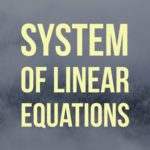Summary: Possibilities for the Solution Set of a System of Linear Equations

Problem 288
In this post, we summarize theorems about the possibilities for the solution set of a system of linear equations and solve the following problems.
Determine all possibilities for the solution set of the system of linear equations described below.
(a) A homogeneous system of $3$ equations in $5$ unknowns.
(b) A homogeneous system of $5$ equations in $4$ unknowns.
(c) A system of $5$ equations in $4$ unknowns.
(d) A system of $2$ equations in $3$ unknowns that has $x_1=1, x_2=-5, x_3=0$ as a solution.
(e) A homogeneous system of $4$ equations in $4$ unknowns.
(f) A homogeneous system of $3$ equations in $4$ unknowns.
(g) A homogeneous system that has $x_1=3, x_2=-2, x_3=1$ as a solution.
(h) A homogeneous system of $5$ equations in $3$ unknowns and the rank of the system is $3$.
(i) A system of $3$ equations in $2$ unknowns and the rank of the system is $2$.
(j) A homogeneous system of $4$ equations in $3$ unknowns and the rank of the system is $2$.
 Add to solve later
Add to solve later
Sponsored Links
Contents
- Problem 288
- the possibilities for the solution set of a system of linear equations
- The case $m \geq n$?
- Solutions.
- (a) A homogeneous system of $3$ equations in $5$ unknowns.
- (b) A homogeneous system of $5$ equations in $4$ unknowns.
- (c) A system of $5$ equations in $4$ unknowns.
- (d) A system of $2$ equations in $3$ unknowns that has $x_1=1, x_2=-5, x_3=0$ as a solution.
- (e) A homogeneous system of $4$ equations in $4$ unknowns.
- (f) A homogeneous system of $3$ equations in $4$ unknowns.
- (g) A homogeneous system that has $x_1=3, x_2=-2, x_3=1$ as a solution.
- (h) A homogeneous system of $5$ equations in $3$ unknowns and the rank of the system is $3$.
- (i) A system of $3$ equations in $2$ unknowns and the rank of the system is $2$.
- (j) A homogeneous system of $4$ equations in $3$ unknowns and the rank of the system is $2$.
the possibilities for the solution set of a system of linear equations
An $m\times n$ system of linear equations is
\begin{align*} \tag{*}
a_{1 1} x_1+a_{1 2}x_2+\cdots+a_{1 n}x_n& =b_1 \\
a_{2 1} x_1+a_{2 2}x_2+\cdots+a_{2 n}x_n& =b_2 \\
a_{3 1} x_1+a_{3 2}x_2+\cdots+a_{3 n}x_n& =b_3 \\
\vdots \qquad \qquad \cdots\qquad \qquad &\vdots \\
a_{m 1} x_1+a_{m 2}x_2+\cdots+a_{m n}x_n& =b_m,
\end{align*}
where $x_1, x_2, \dots, x_n$ are unknowns (variables) and $a_{i j}, b_k$ are numbers.
Thus an $m\times n$ system of linear equations consists of $m$ equations and $n$ unknowns $x_1, x_2, \dots, x_n$.
A system of linear equations is called homogeneous if the constants $b_1, b_2, \dots, b_m$ are all zero. Namely, a homogeneous system is
\begin{align*}
a_{1 1} x_1+a_{1 2}x_2+\cdots+a_{1 n}x_n& =0 \\
a_{2 1} x_1+a_{2 2}x_2+\cdots+a_{2 n}x_n& =0 \\
a_{3 1} x_1+a_{3 2}x_2+\cdots+a_{3 n}x_n& =0 \\
\vdots \qquad \qquad \cdots\qquad \qquad &\vdots \\
a_{m 1} x_1+a_{m 2}x_2+\cdots+a_{m n}x_n& =0.
\end{align*}
A solution of the system (*) is a sequence of numbers $s_1, s_2, \dots, s_n$ such that the substitution $x_1=s_1, x_2=s_2, \dots, x_n=s_n$ satisfies all the $m$ equations in the system (*).
We sometimes use the vector notation and say
\[\mathbf{x}=\begin{bmatrix}
x_1 \\
x_2 \\
\vdots \\
x_n
\end{bmatrix}=\begin{bmatrix}
s_1 \\
s_2 \\
\vdots \\
s_n
\end{bmatrix}\]
is a solution of the system.
For example, every homogeneous system has the zero solution $x_1=0, x_2=0, \dots, x_n=0$, or
\[\mathbf{x}=\begin{bmatrix}
0 \\
0 \\
\vdots \\
0
\end{bmatrix}.\]
Here we summarize several theorems concerning with the possibilities for the number of solutions of a system of linear equations.
We say a system is consistent if the system has at least one solution.
A system is called inconsistent if the system has no solutions at all.
Thus, for example, if we find two distinct solutions for a system, then it follows from the theorem that there are infinitely many solutions for the system.
Next, since a homogeneous system has the zero solution, it is always consistent. Thus:
Let us refine these theorems. Suppose that an $m\times n$ system of linear equations is given. That is, there are $m$ linear equations and $n$ unknowns.
Thus, there are only two possibilities when $m < n$: No solution or infinitely many solutions.
This is obtained by noting that a homogeneous system always has the zero solution, hence consistent. By the previous theorem, the only possibility is infinitely many solutions.
Summary 1
The case $m \geq n$?
What happens when $m \geq n$?
In general, when the number of equations is greater than or equal to the number of unknowns, we cannot narrow down the possibilities.
We need more information about the system. The key word is the rank of the system.
For a given system (*), let $A$ be the coefficient matrix and let $\mathbf{b}$ be the constant term vector. Then we define the rank of the system to be the rank of the augmented matrix $[A\mid \mathbf{b}]$.
Recall that the rank is defined as follows. We first reduce the matrix $[A\mid \mathbf{b}]$ to a matrix $[A’\mid \mathbf{b’}]$ in (reduced) row echelon form by elementary row operations.
Then the rank of $[A\mid \mathbf{b}]$ is the number of nonzero rows in the matrix $[A’\mid \mathbf{b’}]$.
A free variable means an unknown that can be assigned arbitrary values. It follows that if a system has a free variable, then there are infinitely many solutions.
Caution: the theorem assumes that a given system is consistent.
Summary 2
Problems and solutions
Determine all possibilities for the solution set of the system of linear equations described below.
(a) A homogeneous system of $3$ equations in $5$ unknowns.
(b) A homogeneous system of $5$ equations in $4$ unknowns.
(c) A system of $5$ equations in $4$ unknowns.
(d) A system of $2$ equations in $3$ unknowns that has $x_1=1, x_2=-5, x_3=0$ as a solution.
(e) A homogeneous system of $4$ equations in $4$ unknowns.
(f) A homogeneous system of $3$ equations in $4$ unknowns.
(g) A homogeneous system that has $x_1=3, x_2=-2, x_3=1$ as a solution.
(h) A homogeneous system of $5$ equations in $3$ unknowns and the rank of the system is $3$.
(i) A system of $3$ equations in $2$ unknowns and the rank of the system is $2$.
(j) A homogeneous system of $4$ equations in $3$ unknowns and the rank of the system is $2$.
Solutions.
In the solution, $m$ denotes the number of equations and $n$ denotes the number of unknowns in the given system.
(a) A homogeneous system of $3$ equations in $5$ unknowns.
Since the system is homogeneous, it has the zero solution, hence consistent. Since there are more unknowns than equations, there are infinitely many solutions.
(b) A homogeneous system of $5$ equations in $4$ unknowns.
Since the system is homogeneous, it has the zero solution. Since there are more equations than unknowns, we cannot determine further.
Thus the possibilities are either a unique solution or infinitely many solution.
(If the rank $r$ of the system is $4$, then a unique solution. If $r<4$, then there are infinitely many solutions.)
(c) A system of $5$ equations in $4$ unknowns.
Since $m > n$, we can only say that the possibilities are no solution, a unique solution, or infinitely many solution.
(d) A system of $2$ equations in $3$ unknowns that has $x_1=1, x_2=-5, x_3=0$ as a solution.
Since $m < n$, the system is either inconsistent or has infinitely many solutions. Since $x_1=1, x_2=-5, x_3=0$ is a solution of the system, the system is not inconsistent. Thus the only possibility is infinitely many solutions.
(e) A homogeneous system of $4$ equations in $4$ unknowns.
Since $m=n$, this tells nothing. But since the system is homogeneous it has the zero solution, hence consistent. The possibilities are either a unique solution or infinitely many solutions.
(f) A homogeneous system of $3$ equations in $4$ unknowns.
Since $m < n$, the system has no solution or infinitely many solutions. But a homogeneous system is always consistent. Thus, the only possibility is infinitely many solutions.
(g) A homogeneous system that has $x_1=3, x_2=-2, x_3=1$ as a solution.
The possibilities for the solution set for any homogeneous system is either a unique solution or infinitely many solutions. Since the homogeneous system has the zero solution and $x_1=3, x_2=-2, x_3=1$ is another solution, it has at least two distinct solution. Thus the only possibility is infinitely many solutions.
(h) A homogeneous system of $5$ equations in $3$ unknowns and the rank of the system is $3$.
A homogeneous system is always consistent. Since the rank $r$ of the system and the number $n$ of unknowns are equal, the only possibility is the zero solution (and the zero solution is a unique solution).
(i) A system of $3$ equations in $2$ unknowns and the rank of the system is $2$.
We don’t know whether the system is consistent or not.
If it is consistent, then since the rank $r$ and the number of unknowns are the same, the system has a unique solution. Thus the possibilities are either inconsistent or a unique solution.
Before talking about the rank, we need to discuss whether the system is inconsistent or not. For example, consider the following $3\times 2$ system
\begin{align*}
x_1+x_2&=1\\
2x_1+2x_2&=3\\
3x_1+3x_2&=3.
\end{align*}
Then the augmented matrix is
\[\left[\begin{array}{rr|r}
1 & 1 & 1 \\
2 &2 &3 \\
3 & 3 & 3
\end{array}\right].\]
We reduce this by elementary row operations as follows.
\begin{align*}
\left[\begin{array}{rr|r}
1 & 1 & 1 \\
2 &2 &3 \\
3 & 3 & 3
\end{array}\right]
\xrightarrow{\substack{R_2-2R_1\\R_3-3R_1}}
\left[\begin{array}{rr|r}
1 & 1 & 1 \\
0 & 0 &1 \\
0 & 0 &0
\end{array}\right].
\end{align*}
The last matrix is in echelon form and it has two nonzero rows. Thus, the rank of the system is $2$. However, the second row means that we have $0=1$. Hence the system is inconsistent.
(j) A homogeneous system of $4$ equations in $3$ unknowns and the rank of the system is $2$.
A homogeneous system is consistent. The rank is $r=2$ and the number of variables is $n=3$. Hence there is $n-r=1$ free variable. Thus there are infinitely many solutions.
 Add to solve later
Add to solve later
Sponsored Links
















1 Response
[…] the post Summary: possibilities for the solution set of a system of linear equations to review how to determine the number of solutions of a system of linear […]